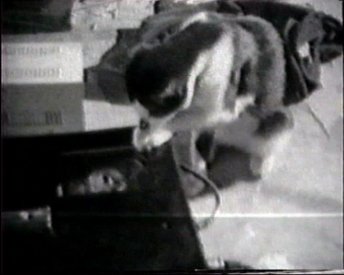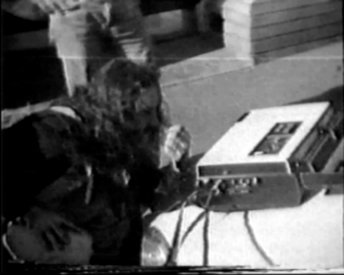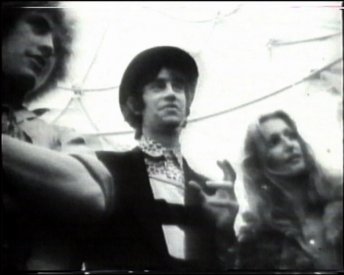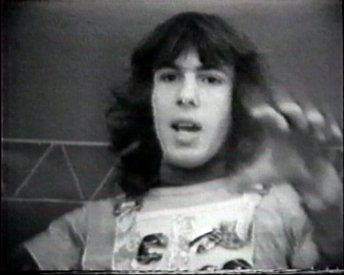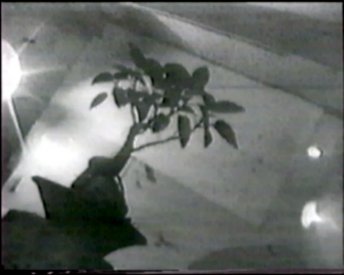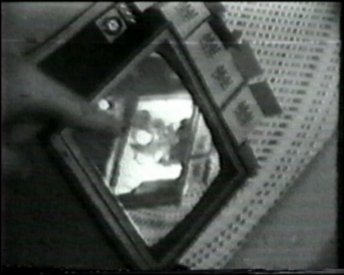Yellow TV
Martin Sharp established the Yellow House in the old Terry Clune Gallery at 59 MacLeay St, Potts Point. With the assistance of Peter (Charlie) Brown, the then manager of Holdsworth Galleries, Sharp installed an exhibition of his collages and paintings on perspex, which opened to wild acclaim on May 21, 1970. The gallery became the focus of the local art scene being used for music, performance, poetry readings and other events. Jon Lewis and Bruce Goold became involved and were invited to contribute. Greg Weight a photographer and friend of Sharp’s photographed all his works. George Gittoes established a “glowing environment for a magic theatre”1 and Albie Thoms suggested that it be expanded into a co-operative art school (which became the Ginger Meggs Memorial School of Art). In early 1971 the building was transformed into the Yellow House and Weight’s photographs of Sharp’s pictures from the initial exhibition were presented as the “Incredible Shrinking Exhibition” opening on April 1, 1971. Sharp had sought to establish a realisation of van Gogh’s late 19th century desire to establish an artists’ commune in Arles and so this new space was based on the van Gogh’s premise that “there is nothing more truly artistic than to love people”.2
Albie Thoms had returned to Australia at the end of 1970 and along with producing the TVX project for The Odyssey rock festival at Wallacia, west of Sydney, had moved in to the Yellow House joining many of the others participants. He ran the Ginger Meggs Memorial School, of which Jon Lewis may have been the only graduate, and a film programme that showed old and new experimental film.
During all this, around the middle of 1971, the sculptor Bruce Copping had proposed an installation work to be executed at Inhibodress gallery in Woolloomooloo. He received funding from the Australian Council for the Arts for the project, which was to include video documentation of the installation process. Peter Kennedy, who was one of the organisers of Inhibodress contacted Thoms, asking if he would be interested in the video aspect of the project, which of course he was. Thoms spoke to Akai, seeking to borrow the 1/4-inch portapak he used for the TVX Wallacia project but it had been sold. However a commercial operator had one for hire so they hired it for two weeks and bought 40 hours of tape. He asked Peter Wright, another resident of the Yellow House, and Mick Glasheen, who was often there, to help with the recording and in July 1971 one or two of them each spent 8 hours a day for two weeks recording the installation process. As Thoms commented in a recent interview:
So one of us, sometimes two of us, would go down each day and tape this show of Bruce Copping, who was stringing string across the gallery and creating patterns of string that reflected light. He actually extended it out into the street outside the gallery. And we were documenting this. The first tape we shot was him stating his objectives, and by about the second week, the exhibition wasn’t going the way he wanted, somehow, and he took that tape. ... And we got very irate, because we saw it as very important to the progression of the whole thing, you know. So we had a stand-off fight and withdrew from the thing. He was also probably pissed off because at nights we would go back to the Yellow House and shoot stuff, what was happening in the Yellow House.3
The Sydney Filmmakers Co-op catalogue describes the Copping video:
The coverage of the sculptor's activities range from documentation through expression-istic improvisation, to real-time recording, interviews, and video improvisations by students and visitors to the gallery. Tapes range from the record of the sculptor's arrival at the gallery and his unloading of ladders through his hanging of drawings, photographs and other aspects of his exhibition, to his stringing activities inside the gallery and in the street outside. These tapes form a record of creative activity as well as a psychological document of the sculptor as he builds himself into a web until this isolates him from the public he sought to attract. One of the final tapes shows him staring mutely at the camera which records his defeated attitude and his inability to communicate. Towards the end of the exhibition the sculptor destroyed an early tape on which he expressed his intentions in creating the exhibition. The final tape shows him ordering the camera out of the gallery, threatening to smash it. However, instead of doing this, the sculptor leaves the gallery, empty save for artworks, and the camera recording the moment.4
At present there is no available copy of the Copping installation video. However while Thoms and his friends had the equipment they also recorded much of the evening activities in the Yellow House. These recordings became the Yellow TV tapes (subsequently edited by Thoms as Akai Ghost Poems) and make a valuable portrait of life in this inner city commune.
The catalogue entry in the Sydney Filmmakers Co-op catalogue continues:
Further experiments were conducted in the Yellow House with video feedback, replaying tapes of previous-time activities and recording the responses as this information is fed into the environment situation. These experiments include a session in which continuous feedback was applied over a period of five hours recording and rerecording so that eventual information on the video screen shows four rerecordings of the original information. Further experiments in rerecording were made shooting off the monitor and adding soundtracks. In addition, tapes were recorded over, partially erasing information already recorded, creating collages that altered time arrangements placing events in nonsequential order, with random juxtaposition and chance associations.5
As Thoms noted in the 2009 interview:
we weren’t getting through as much of [the tape] as we thought we would, so we were using it at night, and just basically experimenting in all sorts of possibilities, and recording things that were happening there, doing a lot of video playback stuff. And Mick [Glasheen] was shooting off the monitor and that was his big buzz.6
And one of the most interesting nights with it was a time-based thing where we’d shoot a tape, put that on the replay and then start shooting the next one. And then that kept on going, so that the final tape had about five or six time things happening in it. And because we’d shoot right into the monitor often you couldn’t tell which one was which.
Both Glasheen and Lewis later became part of the nucleus of Bush Video and Thoms went on to write about the potential liberating effects of video use in the community,7 one example of which was the Nimbin video project that got Bush Video started.
Some years later a VHS copy of selections from Yellow TV was made for Thoms by the then Australian Film and Television Archive. The archive apparently re-shot the video off the screen, for some reason unable to re-record the video directly to VHS. This was called Akai Ghost Poems and the picture accompanying this note are from that tape.
- 1. Joanna Mendelssohn, The Yellow House, 1970-1972, Sydney: Art Gallery of NSW, p.10
- 2. Van Gogh, quoted in Joanna Mendelssohn, The Yellow House, 1970-1972, p.10
- 3. Albie Thoms: interview with Stephen Jones, May 18, 2009.
- 4. Yellow House Commune, “Yellow TV” Sydney Filmmakers Coop catalogue, 1972, p.87.
- 5. Yellow House Commune, “Yellow TV” Sydney Filmmakers Coop catalogue, 1972, p.87.
- 6. Albie Thoms: interview with Stephen Jones, May 18, 2009.
- 7. See, for example "Video Explosion: 1972” and other articles in Albie Thoms, Polemics for a New Cinema, Sydney: Wild & Woolley, (1978).
